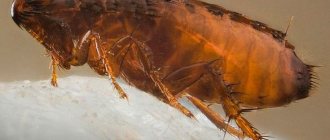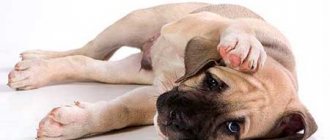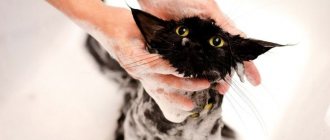Not a single decent, sedate and homely cat is immune from flea infestation, not to mention those that like to walk on their own. But these small blood-sucking insects not only cause pets a lot of anxiety and inconvenience, but are also carriers of various diseases and worm eggs. Therefore, the fight against them must begin immediately, as soon as the animal begins to itch intensely and show signs of nervousness and anxiety.
- 2 Flea shampoos: composition and method of action on parasites
2.1 Video: how flea shampoos work
- 4.1 Photo gallery: anti-flea shampoos for cats
- 5.1 Photo gallery: anti-flea shampoos for kittens
- 6.1 Video: washing your cat with anti-flea shampoo correctly
- 9.1 Video: how to get rid of fleas in the house
The main criteria for choosing flea shampoo for cats
When choosing an antiparasitic detergent for cats, consider 5 factors:
- Age of the animal. Small kittens need specialized products that are less toxic.
- Purpose of application. In case of severe infestation, more effective insecticide-based preparations are used for treatment. For preventive purposes, gentle products, which are dominated by natural soft ingredients, will be sufficient.
- Pet's condition. Sick or weakened animals, as well as pregnant and lactating cats, require more careful treatment.
- Features of the coat. There are special means that take into account the length of the coat or its complete absence.
- Shelf life.
To make an informed decision, it is better to consult a veterinarian who will help you choose the right product.
For small kittens you need to select a special shampoo
Additional necessary measures
Owners of cats infected with fleas must take into account the unpleasant fact that parasites lay eggs throughout the home. In addition to eggs, there may be larvae and cocoons in the house where a pet suffering from bloodsuckers lives.
- The insects themselves can also be outside the animal’s body, because they rarely breed directly in the fur, preferring secluded, inaccessible corners where the cat usually sleeps, eats, and rests.
- Therefore, the treatment of the entire home must necessarily go in parallel with bathing and combing.
- To prevent new flea attacks on your pet, use any convenient protective product. Fortunately, their choice on the zoological goods market is wide.
- You can choose drops, collar or spray. This will allow you to protect your meowing friend for a long time and reliably from possible future invasions of parasites dangerous to health and life.
Important! Remember that fleas can bite people too. Therefore, remove parasites from your pets in a timely manner, or better yet, use preventive protective agents, and then your home will be clean and inaccessible to bloodsuckers, and your entire family, including your cat, will be healthy and not bitten.
Flea shampoos: composition and method of action on parasites
Anti-flea detergents for cats include the following components:
- foaming agents (surfactants);
- decoctions of medicinal herbs (plantain, celandine, coltsfoot, etc.);
- nutritional and caring components;
- essential vegetable oils (citronella, lavender, cloves, etc.);
- insecticides that have a detrimental effect on fleas: synthetic pyrethroids (cypermethrin, phenothrin, permethrin, decamethrin, etofenprox and others);
- natural pyrethroids or similar ones obtained from natural raw materials (pyrethrin contained in the flowers of Caucasian, Persian or Dalmatian chamomile).
A paralyzed flea dies quickly
When the active substance enters the insect's body through the protective chitinous cover, the permeability of nerve cell membranes is disrupted. As a result, the passage of the nerve impulse is blocked, and the paralyzed flea dies after a few minutes. The toxic substance is equally effective on adult insects, eggs and larvae.
Preventive flea shampoos do not contain toxic substances, but are limited to repellent components - extracts of tansy, tea tree, burdock, wormwood and other plants.
Video: how flea shampoos work
Efficiency and operating principle
Analogues of pyrethrins have a destructive effect on the chitinous shell of insects. Modern manufacturers try to use 2nd and 3rd generation pyrethroids.
You should know that the active ingredients destroy bees and fish. This must be taken into account if the owners have an aquarium with fish or a bee apiary.
The principle of action of the foam composition against annoying insects, as well as ticks, is simple and effective:
- When the product hits an insect , it envelops the parasite on all sides with toxic foam;
- The pyrethroids contained in the composition destroy the cocoon of the pupa , chitin of the shell and more adult insects and penetrates into the insect itself;
- After entering the body of a pest , the toxin gradually paralyzes it, depriving it of the strength to move, breathe and drink blood;
- Complete death occurs on the second day after using the shampoo. At this time, not only adult individuals are destroyed, but also their larvae, eggs and pupae. In other words, everything that was in the cat’s fur at the time of bathing is destroyed, leaving no trace behind.
Types of flea shampoos
Anti-flea detergents for cats are divided into two groups:
- Therapeutic (aggressive). Such shampoos contain active ingredients - insecticides. The products are intended for treating animals to kill parasites.
- Preventive (non-aggressive). These shampoos are regularly used to prevent fleas from infesting your pet. They contain non-toxic ingredients.
According to the form of release, zoo shampoos are:
- liquid - ordinary detergents of liquid consistency;
- dry - a fine powder, reminiscent of powder, which is generously sprinkled on the animal’s fur, and then be sure to comb it out thoroughly.
There are a lot of different flea products and shampoos available in stores.
How to bathe a cat correctly?
When using anti-flea detergents, you should bathe your cat following the manufacturer's recommendations.
Usually they advise:
- Do not feed your pet 2-3 hours before bathing.
- Use a bathtub or large basin. Take water at a temperature of about 30 degrees; the liquid should completely cover the paws when the animal is standing.
- Place a rug or towel on the bottom to prevent the cat's paws from slipping, so the cat will feel calmer.
- It is good to wet the fur all over the body, except the head.
- Measure the volume of detergent specified by the manufacturer, foam it in 50 ml of water, and evenly distribute the foam over the animal’s body.
- Leave the foam for 5-10 minutes (as indicated in the instructions). At this time, supervise the cat and do not allow him to lick his fur.
- Rinse off the foam, then rinse the wool well with running water.
- After bathing, wrap the cat in a towel, dry the fur, comb with a fine-tooth comb, and remove insects and their eggs.
Table: comparative characteristics of different types of flea shampoos
| Name | Active substance | Additional Impact | Purpose of application | Use for kittens | For pregnant and lactating cats, as well as weakened or sick animals | Price |
| Leopard |
|
| prevention | allowed | not intended | 180–200 rub. |
| BioVax |
|
| prevention | from 1 month | allowed | 100–140 rub. |
| Celandine |
|
| treatment and prevention | from 8 weeks | not allowed | 110–130 rub. |
| Lugovoy |
|
| treatment and prevention | From 12 weeks | forbidden | 160–200 rub. |
| Doctor Zoo |
|
| prevention, treatment with repeated use | allowed | allowed | 120–140 rub. |
| Ms.Kiss (Miss Kiss) | permethrin (0.5%) |
| treatment | from 4 months | is not allowed | 170–210 rub. |
| Phytoelite |
|
| treatment and prevention | from 2 months | cannot be processed | 90–120 rub. |
| 4 with a tail | citronella oil |
| prevention and short-term protection | from 1 month | permitted with caution | 80–100 rub. |
| BIO-GROOM |
|
| prevention and treatment | from 12 weeks | Not recommended | 1000–1100 rub. |
| Rolf Club |
|
| treatment | from 4 months | prohibited to use | 200–300 rub. |
All pet shampoos against parasites belong to the group of low-toxic drugs (group 4) and are not dangerous to humans.
Photo gallery: anti-flea shampoos for cats
The series of shampoos Four with a tail has a mild preventive effect
BIO-GROOM zoo shampoo has a strong healing effect
Biovax zoo shampoo can be used for kittens from a month of age
Zoo shampoo Doctor Zoo has a therapeutic effect with repeated use Insecticidal shampoo for cats Lugovoy is very popular
Ms.Kiss flea shampoo is inexpensive and effective
Rolf Club flea shampoo is contraindicated for kittens and pregnant cats
The Phytoelite line includes shampoos for cats with different coat types.
Phytoelita shampoo is suitable for cats and dogs
Bars flea shampoo is a preventive product
Insecticidal shampoo Celandine has a positive effect on the condition of the coat due to the content of aloe vera and provitamin B5
Flea shampoos for kittens and pregnant animals
Since all antiparasitic pet shampoos are toxic to a certain extent, they can be safely used only for adult and completely healthy animals. Small kittens, sick and weak pets, as well as pregnant and lactating women should not be washed with such preparations. For this category, special gentle and non-toxic anti-flea detergents have been developed:
- Celandine for puppies and kittens - mild caring insecticidal shampoos with lavender essential oil, their use is recommended for animals from 8 weeks of age;
- Four with a tail - pet shampoos from this manufacturer are safe for kittens after a month of life, as well as for lactating and pregnant cats;
- Phytoelita insecticidal for kittens is a safe natural anti-flea detergent based on an extract of celandine and wormwood;
- Doctor Zoo for kittens is an insecticidal natural well-foaming detergent made using essential oils and herbal extracts, approved for pregnant cats, weak animals and kittens from the third week of life;
- insecticidal shampoo for kittens Gamma - suitable for babies from 8 weeks.
Photo gallery: anti-flea shampoos for kittens
Zooshampoo Gamma can be used for kittens from the third month of life
Good Cat anti-parasitic shampoo for kittens against fleas will help remove parasites and make the coat soft and silky. Dana shampoo belongs to the group of insecticidal preparations with contact action.
Doctor Zoo insecticidal shampoo for kittens is made from natural ingredients
Insecticidal shampoo for kittens Phytoelita is made on the basis of decoctions of celandine and wormwood.
Zoo shampoo Celandine for kittens and puppies contains lavender oil
All insecticidal shampoos intended for kittens can be safely washed by pregnant and lactating cats.
Video: how to remove fleas from a small kitten
General rules of application
- Any drug is first diluted in water before use. This rule must always be observed, regardless of whether it is dry or liquid. If this rule is neglected, the strong concentration of the composition will not allow the animal’s fur to be thoroughly washed, which will cause him a lot of inconvenience.
- Afterwards, the mixture is applied to the animal’s fur and left for the duration of exposure. Depending on the manufacturer, the period may vary, but most often it does not exceed 5 minutes. During this time, you should carefully monitor the animal and hold it tightly enough. If the cat manages to escape, it may begin to lick itself, which is highly undesirable. This may cause the pet's health to deteriorate.
- At the third stage, the cat's fur is thoroughly washed with water;
- The animal's fur is dried and combed.
Advantages and disadvantages of using anti-flea shampoo
The undoubted advantages of liquid flea products include:
- versatility - suitable for cats of all breeds;
- low toxicity;
- ease of use;
- efficiency - fleas die on the second day maximum;
- low cost;
- no side effects;
- positive effect on wool quality.
The disadvantages include the following:
- the possibility of allergic reactions to some components;
- short period of protection (no more than 20 days);
- cheap products are ineffective, and high-quality shampoos are much more expensive;
- Some cats cannot stand water treatments, so shampoo cannot be used.
If our cat suddenly has fleas, we always wash her first with a special anti-flea shampoo, and then put on a protective collar to avoid re-infestation.
How to make your own shampoo
You can make your own shampoo at home.
Shampoo recipe:
Dissolve grated baby soap in 500 g of water and cook over low heat until it becomes jelly-like. Add finely chopped onion, chicken yolk and one teaspoon of nettle or wormwood infusion. Mix everything.
Lather the cat's fur for 10-15 minutes, then rinse with warm water. Plants repel parasites. There are practically no side effects.
At the end of the procedure, the animal must be thoroughly combed. A fine comb will help remove flea eggs.
Contraindications and side effects
A clear contraindication to the use of pet flea shampoo would be individual intolerance to any components and the animal’s violent reluctance to undergo water procedures. A side effect may be intoxication caused by the detergent entering the digestive or respiratory tract, as well as the accumulation of toxic substances due to too frequent use.
If there are strong signs of poisoning (vomiting, weakness, drooling, etc.), you should immediately consult a veterinarian.
Some cats are categorically against water procedures
Reviews
- Svetlana Vasilyeva, 38 years old, Sochi: “I recently picked up a kitten on the street. I was horrified - it was not a kitten, but a complete collection of insects. Without exaggeration! His skin and fur were literally moving. A salesperson at a pet store recommended Celandine to me. Helped a lot!”
- Anna Shipilova, 27 years old, Saratov: “In my grandmother’s village, all the cats have fleas. I bought “Dana” for washing. It is inexpensive, the smell is pleasant, it can be used both against fleas and just for washing. The fleas are out. Now grandma washes them every 2 months using shampoo. Fleas don’t have time to get started”
- Sergey Avdeev, 35 years old, Chekhov: “The shampoo just didn’t help us. The fleas disappeared only after complex use. We combined the detergent composition with Advantix flea drops. The procedure had to be repeated 2 times. I'm happy with the result."
- Alena Mirgorodskaya, 22 years old, Yekaterinburg: “My domestic cats also grabbed these insects somewhere. I figured it out like this: first of all, I washed them with shampoo and put on a collar. Plus, I washed the floors and furniture in the apartment with this same shampoo, but only with diluted shampoo. It helped. By the way, I used “Apit”.
- Elena Oleynikova, 33 years old, Perm: “I use shampoo from the Bio series. It is completely natural and absolutely safe. Kills not only fleas, but also ticks. I bathe my cat with it at least 2 times a season. During this time, insects simply do not have time to appear.”
Safety rules when treating cats with shampoo
When treating an animal with flea shampoo, the following rules must be observed:
- first carefully study the instructions, act strictly according to them and strictly follow the dosage;
- to prevent water from entering, the cat’s ears can first be plugged with cotton tubes soaked in vegetable oil;
- thoroughly rinse the product from the fur and under no circumstances allow the animal to lick itself;
- do not bathe your pet too often.
The instructions must be read very carefully and the recommendations in it must be followed exactly.
Video: how to get rid of fleas in the house
When is the best time to use shampoo?
A foam product, often with a pleasant smell, is a direct-acting method. That is, all parasites currently present in the fur will inevitably die. Together with them, the larvae and pupae of bloodsuckers are doomed to death.
However, shampoo designed for cats against fleas and ticks is considered the least toxic to the animal itself. And here's why: the insecticides included in its composition do not have time to be absorbed into the pet's skin during bathing, but they kill pests - fleas, ticks, lice eaters. This is especially true for small kittens.
Shampoo is best used in urgent situations.
- When a pet “picks up” parasites while walking on the street and communicating with relatives.
- If jumping insects are noticed in the fur of a cat or kittens.
- When a cat is pregnant or nursing a litter and other remedies are too toxic for her, but bloodsuckers bite her regularly.
- If your pet is allergic to long-term anti-parasite medications.
- When the kitten is less than six months old and the bloodsuckers are bothering him too much.
- If the animal suffers excessively from a flea attack.
Important! When there is a suspicion that the cat may have been attacked by ticks, but no embedded ticks were detected during examination, then shampoo can also be effective, only you need to keep the animal soaped longer, but not more than the period specified in the instructions! It’s better to look for ticks more carefully and remove them according to the rules.










